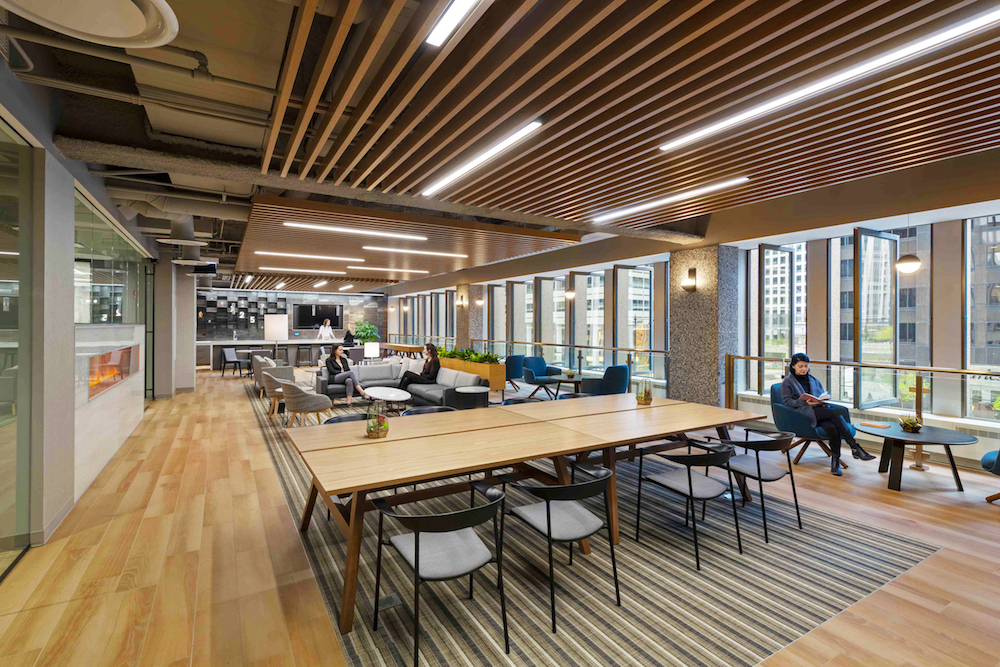Wright Heerema Architects’ Cary Chandler and Ellen Lieder share a few ways downtown office buildings can reinvent themselves as urban workplace destinations.

When workers return to urban office towers, they’ll be expecting much more than a desk – they’ll expect a workplace destination, an exceptional experience that delivers more than their home office could ever offer. While in the short-term building owners have been addressing immediate safety issues and protocols, the longer term is looming. The long-lasting impacts of the pandemic on the office environment are still unknown, but it’s clear that people will need in-person human interaction to find meaning and collaboration at work. Now that a desk at the office has become a luxury rather than a given, the need has risen to likewise deliver more than places to perform tasks. The workplace must now deliver a first impression that will serve as a rallying cry for community building and shared purpose, productive individual spaces, and third places that support innovation and collaboration that can’t be replicated in a home office environment.
All this from an office building? Absolutely. The office isn’t dead – especially in the city. Office buildings can still provide a third place between home and the desk to help workers find their productivity. Here are a few ways downtown office buildings can reinvent themselves as urban workplace destinations.

Complement the neighborhood
The urban environment is dense and rich; a socially activated building will provide offerings that fill gaps in existing nearby amenities, bringing together the fabric of the neighborhood. Identifying the right spaces in the building for community amenities is a huge success factor when transforming an underperforming building – and also a significant factor as you look to optimize the renovation budget.
For example, if a building is located on a block with multiple coffeeshops, a lobby café might not be necessary. But if all of the nearby restaurants are higher-end sit-down spots, a grab-and-go kiosk with prepackaged meals and snacks – along with lobby seating – could provide workers with a quick bite and a place to enjoy it.
Additionally, if an office building has an ample courtyard or outdoor space, building owners could provide several seating areas for tenants and city dwellers alike to enjoy socially distant meals or meetings.

Make the first impression count
The building exterior, entrances and lobbies have always formed the trifecta of a building’s first impression. However, the goal of first impressions has evolved over time and your building may (or may not) have kept up with changing notions. In past decades the goal of an urban office building’s first impression was to impress with scale and finishes; today the goal is to humanize and connect. Building owners should consider replacing dark and outdated finishes with lighter, more natural modern finishes and materials to welcome tenants and visitors.
On building tours, leaders must be able to imagine themselves and their workforce in the space on a daily basis, and activating the lobby is essential and cafés and professional lounge spaces play an important role in that process. At an in-progress project at 200 S. Wacker, we listened to the needs of the building owner and were able to balance ambitious first-floor plans with their desired budget. The design complements the lobby, which is already very active, with additional seating and updated finishes to encourage even more social activity.
The third place can make the office building a true destination
Landlords are now not just responsible for the “second place” (the office), but also for creating the “third place” that is neither home nor office. Creating an intentional community within the building makes an office building not just someplace to go to work, but to belong. Like a front porch, shared lounges serve as a transition between public and private spaces. And while current health guidelines might not allow for socializing indoors, the day will come when it is safe again and workers will yearn for this kind of connection at their workplace.
The lounge at 123 N. Wacker for example, employs lounge furniture suited for comfortable yet functional working positions and sophisticated layering of patterns and texture that invite professionals to relax and unwind together. The building owners also installed a full-time barista, supporting spontaneous collaboration.

Designing shared amenities with an eye to the buildings’ tenants can further curate the building experience. With a mix of wealth managers and other services for high net worth individuals at 980 N. Michigan, we ensured the lobby, lounge and other shared spaces had luxury finishes responsive to those tenants’ expectations.
In other cases, shared amenities such as fitness centers can provide additional space for tenants to utilize between home and the office. Installing a fitness center in a space that doesn’t get much natural light or might not command top office rents can creatively add value for the building by becoming a shared space. Plus, giving tenants a third place that provides the opportunity to get active can help boost their productivity – and finally get away from that home gym.
No two urban office buildings are the same
Urban office buildings come in many shapes, sizes and locations, but they are facing similar challenges. Many companies have pressed pause on office leasing decisions for the short term, and it’s likely that occupancy won’t return to pre-pandemic levels until a viable vaccine or treatment is widely available for the public. Building owners should take great care to shape a building environment as a destination for returning workers, both in the near future and for years to come.

